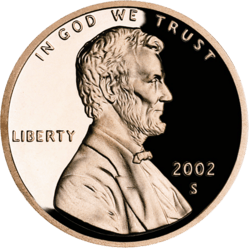Penny (United States coin)
The United States one-cent coin (symbol: ¢), often called the penny, is a unit of currency equaling one one-hundredth of a United States dollar. It has been the lowest-value physical unit of U.S. currency since the abolition of the half-cent in 1857 (the abstract mill, which has never been minted, equal to a tenth of a cent, continues to see limited use in the fields of taxation and finance). The first U.S. cent was produced in 1787, and the cent has been issued primarily as a copper or copper-plated coin throughout its history. Its obverse has featured the profile of President Abraham Lincoln since 1909, the centennial of his birth. From 1959 (the sesquicentennial of Lincoln's birth) to 2008, the reverse featured the Lincoln Memorial. Four different reverse designs in 2009 honored Lincoln's 200th birthday and a new, "permanent" reverse – the Union Shield – was introduced in 2010. The coin is 0.75 inches (19.05 mm) in diameter and 0.0598 inches (1.52 mm) in thickness. Its weight has varied, depending upon the composition of metals used in its production (see further below).
United States | |
| Value | 0.01 U.S. Dollars |
|---|---|
| Mass | (1982-present) 2.5 g (0.08 troy oz) |
| Diameter | 19.05 mm (0.75 in) |
| Thickness | 1.52 mm (0.0598 in) |
| Edge | Plain |
| Composition | (1982–present) copper-plated zinc 97.5% Zn, 2.5% Cu |
| Years of minting | 1793–present |
| Catalog number | – |
| Obverse | |
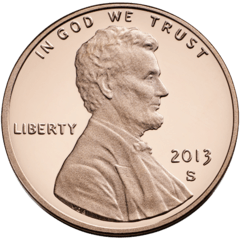 | |
| Design | Abraham Lincoln |
| Designer | Victor D. Brenner |
| Design date | 1909 (modified since) |
| Reverse | |
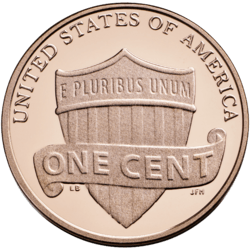 | |
| Design | Union Shield |
| Designer | Lyndall Bass |
| Design date | 2010–present |
The U.S. Mint's official name for the coin is "cent"[1] and the U.S. Treasury's official name is "one cent piece".[2] The colloquial term penny derives from the British coin of the same name, which occupies a similar place in the British system. In American English, pennies is the plural form (the plural form pence—standard in British English—is not used in reference to American coins). In the early 2010s the price of metal used to make pennies rose to a noticeable cost to the mint which peaked at more than $0.02 for the $0.01 face-value coin. This pushed the mint to look for alternative metals again for the coin, and also brought the penny debate into more focus. There are currently no firm plans to eliminate the penny as arguments for and against the coin continue to be debated.[3]
History of composition
| Years | Material | Weight (grains) | Weight (grams) |
|---|---|---|---|
| 1793–1795 | ~100% copper | 208 grains | 13.48 |
| 1795–1857 | ~100% copper | 168 grains | 10.89 |
| 1856–1864 | 88% copper, 12% nickel (also known as NS-12) | 72 grains | 4.67 |
| 1864–1942 | bronze (95% copper, 5% tin and zinc) | 48 grains | 3.11 |
| 1943 | zinc-coated steel (also known as 1943 steel cent) | 42 grains | 2.72 |
| 1944–1946 | gilding metal (95% copper, 5% zinc) | 48 grains | 3.11 |
| 1947–1962 | bronze (95% copper, 5% tin and zinc) | 48 grains | 3.11 |
| 1962–1982 | gilding metal (95% copper, 5% zinc) | 48 grains | 3.11 |
| 1982–present | copper-plated zinc (97.5% zinc, 2.5% copper) | 38.6 grains | 2.5 |
In honor of Lincoln's 200th anniversary, special 2009 cents were minted for collectors in the same composition as the 1909 coins.[5]
The isotope composition of early coins spanning the period 1828 to 1843 reflects the copper from Cornish ores from England, while coins after 1850 reflect the Keweenaw Peninsula, Michigan ores, a finding consistent with historical records.[6]
In 1943, at the peak of World War II, zinc-coated steel cents were made for a short time because of war demands for copper. A few copper cents from 1943 were produced from 1942 planchets remaining in the bins. Similarly, some 1944 steel cents have been confirmed. From 1944 to 1946, salvaged ammunition shells made their way into the minting process, and it was not uncommon to see coins featuring streaks of brass or having a considerably darker finish than other issues.
During the early 1970s, the price of copper rose to the point where the cent contained almost one cent's worth of copper. This led the Mint to test alternative metals, including aluminum and bronze-clad steel. Aluminum was chosen, and over 1.5 million of these aluminum pennies dated 1974 were struck and ready for public release before ultimately being rejected. The aluminum cents were rejected for two reasons: vending machine owners complained the coins would easily jam machines, causing various mechanical problems; and pediatricians and pediatric radiologists pointed out that if children ingested aluminum pennies, the coins would be difficult to detect using x-ray imaging because the radiodensity of the metal inside the respiratory and gastrointestinal tracts was similar to that of soft tissue.[7] Most of these aluminum cents were destroyed, but a few have survived, one example being donated to the Smithsonian Institution.
The cent's composition was changed in 1982 because the value of the copper in the coin started to rise above one cent.[8] Some 1982 pennies used the 97.5% zinc composition, while others used the 95% copper composition. With the exception of 2009 bicentennial cents minted specifically for collectors, United States cents minted after 1982 have been zinc with copper plating. In Fiscal Year (FY) 2013, the average one-cent piece minted cost the U.S. Mint 1.83 cents, down from 2.41 cents apiece in FY 2011.[9]
The bronze and copper cents can be distinguished from the newer zinc cents by dropping the coins on a solid surface. The predominantly zinc coins make a lower-pitched "clunk", while the copper coins produce a higher-pitched ringing sound.[10] In addition, a full 50-cent roll of pre-1982/3 coins weighs 5.4 oz (150 g) compared to a post-1982–83 roll which weighs 4.4 oz (120 g).
Mintage figures for the penny can be found at United States cent mintage figures.
Designs
The coin has gone through several designs over its two-hundred-year time frame. Until 1857 it was about the size of the current U.S. dollar coins (Susan B. Anthony through present dollars).


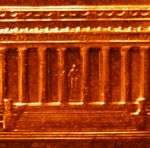
The following types of cents have been produced:
Large cents:
- Flowing Hair Chain 1793
- Flowing Hair Wreath 1793
- Liberty Cap 1793–1796
- Draped bust 1796–1807
- Classic Head 1808–1814
- Coronet 1816–1839
- Braided Hair 1839–1857, 1868 (not a regular issue)
Small cents:
- Flying Eagle cent (1856–1858)
- Indian Head cent (1859–1909)
- Lincoln cent (1909–present)
- Lincoln Wheat (1909–1958)
- Lincoln Memorial (1959–2008)
- Lincoln Bicentennial 4 reverse designs (2009)
- Lincoln Union Shield[11] (2010–present)
Throughout its history, the Lincoln cent has featured several typefaces for the date, but most of the digits have been old-style numerals, except with the 4 and 8 neither ascending nor descending. The only significant divergence is that the small 3 was non-descending (the same size as a 0, 1, or 2) in the early history, before switching to a descending, large 3 for the year 1934 and then permanently (as of 2014) in 1943. Similarly, the digit 5 was small and non-descending up to 1945. From 1959 until 2008, the Lincoln Memorial was shown on the reverse of the United States cent. Because the Lincoln Memorial was shown in sufficient detail to discern the statue of Lincoln on the reverse, Abraham Lincoln was at that time the only person to be depicted on both the obverse and reverse of the same United States coin. In 1999, the New Jersey state quarter was released, which depicts George Washington on both sides, crossing the Delaware River on the reverse side and in profile on the obverse. (The state quarter for South Dakota, released in 2006, also features Washington on both sides: the typical profile on the obverse, and Washington within Mount Rushmore on the reverse.) Some of the 2009 reverse design series no longer showed Abraham Lincoln, and the 2010 Lincoln Union Shield has removed the president from the coin reverse for the foreseeable future.
An additional design detail that is not readily visible to the naked eye is found on the obverse side of the 1918 onward United States cent. The letters "VDB" stamped on the bottom sleeve of Abraham Lincoln represent the initials of Victor David Brenner, the primary designer of the Wheat cent. He was still alive to see the change and no controversies arrived.
Lincoln cent
The Lincoln cent is the current one-cent coin of the U.S. It was adopted in 1909 (which would have been Lincoln's 100th birthday), replacing the Indian Head cent. Its reverse was changed in 1959 from a wheat-stalks design to a design which includes the Lincoln Memorial (to commemorate Lincoln's sesquicentennial) and was replaced again in 2009 with four new designs to commemorate Lincoln's bicentennial. There are more one-cent coins produced than any other denomination, which makes the Lincoln cent a familiar item. In its lifespan, this coin has weathered both world wars, one of which temporarily changed its composition as part of the war effort. The obverse design is the longest produced for any circulating American coin.
History
When the Lincoln one-cent coin made its initial appearance in 1909, it marked a radical departure from the accepted styling of United States coinage, as it was the first regular coin to bear a portrait other than the mythical Liberty which appeared on most pre-1909 regular coins. Previously, a strong feeling had prevailed against using portraits on coins in the United States, but public sentiment stemming from the 100th anniversary celebration of Abraham Lincoln's birth proved stronger than the long-standing tradition.
A variety of privately minted tokens bearing Lincoln's image circulated as one-cent pieces during Lincoln's presidency; legitimate coinage had become scarce during the Civil War. These early tokens undoubtedly influenced the denomination, appearance, size, and composition of Lincoln cents.
Theodore Roosevelt, the 26th U.S. President, thought American coins were so common and uninspiring that he attempted to get the motto "In God We Trust" removed as offending religion. Roosevelt had the opportunity to pose for a young Lithuanian-born Jew, Victor David Brenner, who, since arriving nineteen years earlier in the United States had become one of the nation's premier medalists. Roosevelt had learned of Brenner's talents in a settlement house on New York City's Lower East Side and was immediately impressed with a bas-relief that Brenner had made of Lincoln, based on a Mathew Brady photograph. Roosevelt, who considered Lincoln the savior of the Union and the greatest Republican President, and who also considered himself Lincoln's political heir, ordered the new Lincoln cent to be based on Brenner's work and to be released just in time to commemorate Lincoln's 100th birthday in 1909. The likeness of President Lincoln on the obverse of the coin is an adaptation of a plaque Brenner created several years earlier which had come to the attention of President Roosevelt in New York.[12]
In addition to the prescribed elements on U.S. coins—LIBERTY and the date—the motto In God We Trust appeared for the first time on a coin of this denomination. The United States Congress passed the Act of March 3, 1865, authorizing the use of this motto on U.S. coins,[13] during Lincoln's tenure in office.
Even though no legislation was required for the new design, approval of the Secretary of the Treasury was necessary to make the change. Franklin MacVeagh gave his approval on July 14, 1909, and not quite three weeks later, on August 2, the new coin was released to the public.
In 1918, after the controversy over Brenner's name and initials on the reverse had died down, his initials were placed on the obverse with no further controversy. They are to be found in minute form on the rim of the bust, just under the shoulder of Lincoln.
In 1969, the design was revised to make Lincoln look more like Brenner's original sculptures.

Reverse design
| Reverses of the Lincoln cent |
|---|
 Wheat (1909–1958) |
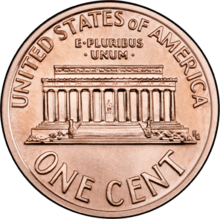 Lincoln Memorial (1959–2008) |
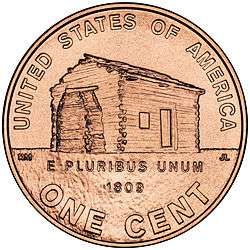 Birth and early childhood in Kentucky (Lincoln Bicentennial, 2009) |
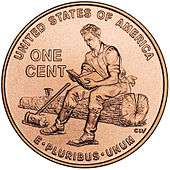 Formative Years in Indiana (Lincoln Bicentennial, 2009) |
 Professional life in Illinois (Lincoln Bicentennial, 2009) |
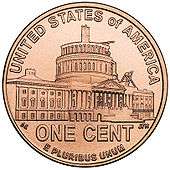 Presidency in DC (Lincoln Bicentennial, 2009) |
 Union shield (2010–present) |
Wheat cent (1909–1958)
A study of three potential reverses resulted in the approval of a very simple design bearing two wheatheads in memorial style. Between these, in the center of the coin, are the denomination and UNITED STATES OF AMERICA, while curving around the upper border is the national motto, E Pluribus Unum, Latin for "Out of Many, One".
The original model bore Brenner's name on the reverse, curving along the rim below UNITED STATES OF AMERICA. Before the coins were issued, however, the initials "VDB" were substituted because officials at the United States Mint felt the name was too prominent. After the coin was released, many protested that even the initials were conspicuous and detracted from the design. Because the coin was in great demand, and because to make a change would have required halting production, the decision was made to eliminate the initials entirely.
Thus in 1909 the U.S. had six different cents: the 1909 and 1909-S Indian Head cents, and four Lincoln coins: 1909 VDB, 1909-S VDB, 1909 and 1909-S. In all cases the Philadelphia mintages far exceeded the San Francisco issues. While the smallest mintage is the '09-S Indian, the '09-S VDB is the key Lincoln date, and hence is most valuable. Its mintage of 484,000 is only 1.7% of the plain V.D.B.
Lincoln Memorial cent (1959–2008)
On February 12, 1959, a revised reverse design was introduced as part of the 150th anniversary of Lincoln's birth. No formal competition was held. Frank Gasparro, then Assistant Engraver at the Philadelphia Mint, prepared the winning entry, selected from a group of 23 models that the engraving staff at the Mint had been asked to present for consideration. Again, only the approval of the Secretary of the Treasury was necessary to make the change because the design had been in use for more than the required 25 years. The imposing marble Lincoln Memorial provides the central motif, with the legends E Pluribus Unum and UNITED STATES OF AMERICA completing the design, together with the denomination. The initials "FG" appear on the right, near the shrubbery.
Lincoln Bicentennial cents (2009)
The Presidential $1 Coin Act of 2005 required that the cent's reverse be redesigned in 2009. This resulted in the mintage of four different coins showing scenes from Abraham Lincoln's life in honor of the bicentennial of his birth.
These four designs, unveiled September 22, 2008 at a ceremony held at the Lincoln Memorial on the National Mall in Washington, D.C., are:
- Birth and early childhood in Kentucky: this design features a log cabin and Lincoln's birth year 1809. It was designed by Richard Masters and sculpted by Jim Licaretz. This cent was released into circulation on Lincoln's 200th birthday, February 12, 2009, at a special ceremony at LaRue County High School in Hodgenville, Kentucky, Lincoln's birthplace.[14] The mintage was extremely low compared to prior years (see Lincoln cent mintage figures). It has been nicknamed the "Log Cabin Penny".
- Formative years in Indiana: this design features a young Lincoln reading while taking a break from rail splitting. It was designed and sculpted by Charles Vickers. Nicknamed the "Indiana Penny", it was released on May 14, 2009.[15]
- Professional life in Illinois: this design features a young professional Lincoln standing before the Springfield Illinois State Capitol. It was designed by Joel Iskowitz and sculpted by Don Everhart. Nicknamed the "Illinois Penny", it was released on August 13, 2009.[15]
- Presidency in Washington, D.C.: this design features the half-completed Capitol dome. It was designed by Susan Gamble and sculpted by Joseph Menna. This fourth cent was released to the public on November 12, 2009.[15] U.S. Mint released collector's sets containing this design in copper prior to the public launch of this design in zinc.
Special 2009 cents struck for sale in sets to collectors had the metallic copper content of cents minted in 1909 (95% copper, 5% tin and zinc). Those struck for circulation retained the normal composition of a zinc core coated with copper.
Union shield cent (2010–present)
The 2005 act that authorized the redesign for the Bicentennial stated that another redesigned reverse for the Lincoln cent will be minted which "shall bear an image emblematic of President Lincoln's preservation of the United States of America as a single and united country".[16] Eighteen designs were proposed for the reverse of the 2010 cent.[17] On April 16, 2009 the Commission of Fine Arts (CFA) met and selected a design that showed 13 wheat sheaves bound together with a ring symbolizing American unity as one nation.[18] Later this design was withdrawn because it was similar to coinage issued in Germany in the 1920s.[19] The Citizens Coinage Advisory Committee later met and chose a design showing a Union shield with ONE CENT superimposed in a scroll; E Pluribus Unum was also depicted in the upper portion of the shield.[19][20] In June 2009 the CFA met again and chose a design featuring a modern rendition of the American flag.[21] As a part of the release ceremony for the last of the 2009 cents on November 12, the design for the 2010 cent was announced.[22] The design chosen was the one that was chosen earlier by the CCAC.[22] According to the Mint, the 13 stripes on the shield "represent the states joined in one compact union to support the Federal government, represented by the horizontal bar above".[23] The Mint also noted that a shield was commonly used in paintings in the Capitol hallways painted by Constantino Brumidi, an artist in the Capitol active during the Lincoln Presidency.[23] The obverse of the cent was also changed to a modern rendition of Brenner's design.[24][22] The new Union Shield design replaces the Lincoln memorial in use since 1959.[22] The coin was designed by artist Lyndall Bass and sculpted by U.S. Mint sculptor-engraver Joseph Menna.[25] In January 2010, the coins were released early in Puerto Rico;[26] this was caused by a shortage of 2009-dated pennies on the island.[24] The new design was released at a ceremony at the Abraham Lincoln Presidential Library in Springfield, Illinois on February 11, 2010.[27] In 2017, cents minted in Philadelphia were struck with a "P" mintmark to celebrate the 225th anniversary of the U.S. Mint. 2017 is the only year that Philadelphia cents have had a mintmark.[28]
"Capped cents"
To commemorate the Fire at the SS Morro Castle, local coin dealer Louis Werner made copper caps depicting the Morro Castle surrounded by the legend "The Morro Castle Fire" These were then encased over one side of a Lincoln cent. According to "Mrs. Astor's Horse" by Stanley Walker:
Concessionaires inside the hall carried on a lively business. A man at a stamping machine put copper caps on pennies with the head of Lincoln on one side and the inscription ff Morro Castle Fire, September, 1934, Asbury Park" on the other. Postcard sellers in the hall disposed of 150,000 pictures of the burning ship during the first few days after the disaster. As soon as they came off the press, heart-rending poems and ballads about the fire were hawked about.[29]
Later, to commemorate the trial of Bruno Richard Hauptmann, Werner made another design depicting the Hunterdon County Courthouse, where the trial was held, and surrounded by the legend "HAUPTMANN TRIAL, Flemington, NJ".[30] Another part of the text in "Mrs. Astor's Horse" states:
A man with a metal press did a fair sort of business. He set up for business on the porch of the hotel. He had constructed a die depicting the Hunterdon County courthouse, surrounded by the legend, Hauptmann Trial, Flemington, N.J. On the stand beside the press lay several hundred bright new pennies and several fine strips of copper. By running the copper strips through the press, together with the pennies, he turned out Lincoln heads backed by the courthouse and the legend. The pieces sold for five cents each, three for a dime.[29]
Also, from 1935 to 1938, during the Christmas season, Werner made a design depicting Santa Claus. Shoppers in Manhattan received these by donating 10 cents; if they donated an extra 5 cents, their cent came in a greeting card holder.[31] Other capped cents by Werner include commemoratives for Admiral Richard E. Byrd's expedition to the South Pole and Joe Louis. There was also a design featuring the Lord's prayer.
Composition
Bronze, 1909–1942. Initially the alloy of the Lincoln cent followed that established for this denomination with the Indian Head design in 1864, 95% copper and 2.5% tin and 2.5% zinc.
Wartime zinc-plated steel, 1943. The composition of the Lincoln cent was changed in 1943.
Production of the war-time cent was provided for in an Act of Congress approved on December 18, 1942, which also set as the expiration date of the authority December 31, 1946. Low-grade carbon steel formed the base of these coins, to which a zinc coating 0.0005-inch (0.013 mm) thick was deposited on each side electrolytically as a rust preventive. This coating was applied to the steel before the blanks were made, leaving the rims of these coins extremely susceptible to rust. The same size was maintained, but the weight was reduced from the standard 48 grains (3.1 g) to 42 grains (2.7 g), by using a lighter alloy. Production commenced on February 27, 1943, and by December 31 of that year, the three Mint facilities had produced 1,093,838,670 of the one-cent coins. The copper released for the war effort was enough to meet the combined needs of two cruisers, two destroyers, 1,243 Flying Fortresses, 120 field guns and 120 howitzers, or enough for 1,250,000 shells for large field guns.[32][33]
Wartime brass, 1944–1946. Numerous complaints about the gray color of the 1943 cents, especially that they could be mistaken for dimes, led to a change in composition of the wartime cent. On January 1, 1944, the Mint was able to adopt a modified alloy, the supply being derived from expended shell casings which, when melted, furnished a composition similar to the original, but with a much smaller trace of tin. The original weight of 48 grains (3.1 g) was also restored.
Bronze, 1947–1962. Shell casings were no longer used after 1946 and the original copper-tin-zinc "bronze" composition was again used.
Brass, 1962–1982. The composition of the coin was changed again slightly in 1962. Mint officials felt that deletion of the tin content would have no adverse effect on the wearing qualities of the coin, whereas the manufacturing advantages to be gained with the alloy stabilized at 95% copper and 5% zinc would be of much benefit. Congressional authority for this modification is contained in an Act of Congress approved on September 5, 1962.
Experimental aluminum cents, 1974. During the early 1970s, the price of copper rose to a point where the cent almost contained one cent's worth of copper. This led the Mint to test alternate metals, including aluminum and bronze-clad steel. Aluminum was chosen, and in 1973, a total of 1,579,324 such coins were struck (dated 1974) and ready for public release. A few were distributed to members of the U.S. Congress, but aluminum was ultimately rejected for a variety of reasons. About a dozen aluminum cents are believed to still be in the hands of collectors, although they are now considered illegal to own.[34] One aluminum cent was donated to the Smithsonian Institution. Another is in the hands of the family of a deceased U.S. Capitol police officer, known as the Toven Specimen, and was certified as authentic in 2005.[35]
Copper-plated zinc, 1982–present. In mid-1982, the coin's composition was changed again, this time to copper-plated zinc. The last mostly-copper cents (95% copper metal composition) were produced by the Denver Mint on October 22, 1982. The copper-plated zinc cent coins are still being produced today. They are composed of an inner core alloy of 99.2% zinc and 0.8% copper with an outer plating of pure copper, for an overall composition of 97.5% zinc and 2.5% copper, and are minted on blanks produced for the Mint by an outside manufacturer (Jarden Zinc Products). Except for the new lighter total coin weight of 2.5 grams each, these newer coins are identical in diameter and thickness, and nearly in appearance, to the mostly copper (95%) cents issued before mid-1982, which weighed 3.11 grams each. A few pennies were struck by error in brass dated 1983 and are extremely rare.[36]
Matte Proof Lincolns 1909 to 1916
When the Lincoln Cent was introduced in 1909, it was discovered that the coining dies and their curved fields were unable to be polished to proof coining condition by existing Mint equipment. To produce Proof coinage for collectors, the U.S. Mint adopted the French technique of the Matte Proof, which was thought to highlight the design, while leaving the details of the coin as the designer intended. This was done by a sandblasting of the dies prior to use. When struck by the high pressure hydraulic press of the Philadelphia Mint Medal Room, the result was a semi-rough surface, a gentle luster and strongly defined wide square rims. These coins were produced in very small numbers, and the dies quickly developed small marks, known as diagnostics. These marks are used today by Third Party Graders and Collectors to authenticate the coin. Sold for mere pennies over face during the years of production, they were not popular with collectors. When new, the coins were wrapped in a tarnish-proof tissue, which over time proved to be anything but. Since many of these coins sat for decades unsold, vivid colors and toning developed. It is not unusual to see vivid blues, greens, lavender, coppery orange, deep reds and purple hues on these coins. Eagerly collected by numismatists today, they are among the most valuable Lincoln cents. Unencapsulated coins are easily identified by wide, square outer rims, quite unlike the rounded edges of business strikes.
Mint errors specific to Lincoln cents
Through mint errors, a number of rare and valuable Lincoln Cents have been produced. Some random errors, such as an off-center strike, slightly increase the value of the coin, and are sought after by niche collectors. However some errors were systemic, and produced a number of coins with exactly the same problem in the same year. These have become recognized varieties that are often extremely valuable and sought after by mainstream collectors.
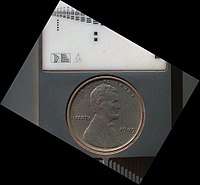
The first Doubled Die error occurred during the production of the 1909 VDB. Not identified until the 1970s, it shows the RTY in Liberty and the 190 of the date slightly doubled. This coin is extremely rare in high grades.
In 1922, no one-cent coins were produced by the Philadelphia Mint. However, three of the four pairs of Denver Mint worn and overly polished dies then produced the Weak D and No D varieties, making them appear as if they had been produced in Philadelphia. These varieties are known as the 1922 plain cents or 1922 no "D" cents. Collectors must be wary of removed mint marks.
There are a few 1943 cents that were produced in bronze, as opposed to the steel/zinc composition used that year. There are 10 to 12 known to exist.[37] Likewise, a few 1944 cents were produced in steel/zinc.
In 1955, a hubbing error caused some cents to get struck with an obverse die which showed doubling in all of the obverse devices, producing a prominent doubling of the date, and to a less noticeable degree, the rest of the obverse. This is known as the 1955 doubled die cent. A similar die error occurred in 1969 on dies used at the San Francisco Mint. While the 1955 doubled die cent is well-known and widely collected, the 1969-S doubled die is far rarer, with an uncirculated specimen selling for as much as $126,500 in a 2008 Heritage auction.[38] The same mechanism produced 1972, 1983, 1984, and 1995 Doubled die cents. Doubled Dies are known for practically every date in the Lincoln cent series, but most are minor, and less impressive compared to the 1955 and the other Doubled Die varieties mentioned here.
In 1990, 3,055 proof cents were struck at the San Francisco Mint without the "S" mint mark, making them appear as if they had been struck at the Philadelphia Mint. However, as no proof cents were struck in Philadelphia that year, they are easily distinguishable as errors, and highly valuable.
The reverse of some Lincoln cents minted in 1992 at the Philadelphia and Denver mints and some of those minted in 1998 and 1999 at the San Francisco mint feature a smaller-than-normal gap between the first two letters of AMERICA. These coins, known as the Close AM variety are valued at $20,000 and $5,000 for the 1992 specimens in gem uncirculated condition and $3,000 and $1,000 for the San Francisco specimens in gem proof condition.
The reverse of some Lincoln cents minted in 1998, 1999, and 2000 in Philadelphia feature a larger-than-normal gap between the first two letters of AMERICA. These coins, known as the Wide AM variety are valued at $10, $500, and $5, respectively, in gem uncirculated condition. These reverse die errors are technically "mule" errors, as the reverse error dies were the same as normal proof coins of the same date.
Toxicity
Zinc, a major component of U.S. cents minted after mid-1982, is toxic in large quantities. Swallowing such a coin, which is 97.5% zinc, can cause damage to the stomach lining because of the high solubility of the zinc ion in the acidic stomach.[39] Coins are the most commonly ingested foreign body in children but generally are allowed to pass spontaneously unless the patient is symptomatic.[40] Zinc toxicity, mostly in the form of the ingestion of U.S. pennies minted after 1982, is commonly fatal in dogs where it causes a severe hemolytic anemia.[41] It is also highly toxic in pet parrots and can often be fatal.[42]
Numismatics and regulations
It has been suggested that the cent should be eliminated as a unit of currency for several reasons including that many Americans do not actually spend them, but rather only receive them in change at stores and proceed to return them to a bank for higher denomination currencies, or cash them in at coin counting kiosks. Most modern vending machines do not accept pennies, further diminishing their utility, and the production cost (figured in U.S. Dollars) now exceeds the face value of the coin, caused by increasing inflation.[43] In 2001 and 2006, for example, United States Representative Jim Kolbe (R) of Arizona introduced bills which would have stopped production of pennies (in 2001, the Legal Tender Modernization Act, and in 2006, the Currency Overhaul for an Industrious Nation [COIN] Act).[44]
In anticipation of the business of melting down U.S. pennies and U.S. nickels for profit, the U.S. Mint, which is a part of the US Department of the Treasury, implemented new regulations[45] on December 14, 2006, which criminalize the melting of pennies and nickels and place limits on export of the coins. Violators can be punished with a fine of up to $10,000 USD and/or imprisoned for a maximum of five years.[46]
Metal content and manufacturing costs
The U.S. Mint reported that in fiscal year 2010 the unit cost of producing and shipping one-cent coins was 1.79 cents, which is more than the face value of the coin.[47] After reaching a peak cost of 2.41 cents in 2011 due to the significant rise in global metal demand and prices, the cost declined to 1.83 cents for 2013.[48] In the 2014 fiscal year, the cost to produce a penny declined even further to 1.70 cents.[49]
When copper reached a record high in February 2011,[50] the melt value of a 95% copper penny was more than three times its face value. As of January 21, 2014, a pre-1982 penny contained 2.20325 cents' worth of copper and zinc, making it an attractive target for melting by people wanting to sell the metals for profit. In comparison, post-1982 copper-plated zinc cents have a metallurgical value of only 0.55152 cents.[51]
As of 2015, based on the U.S. Mint Annual Report released for 2014, it costs the U.S. Mint 1.67 cents (down from 2.41 cents in 2011 and 1.83 cents in 2013) to make one cent because of the cost of materials, production, and distribution.[52] This figure includes the Mint's fixed components for distribution and fabrication, as well as Mint overhead allocated to the penny. Fixed costs and overhead are absorbed by other circulating coins.[53] The loss from producing the one cent coin in the United States for the year of 2013 was $55,000,000. This was a slight decrease from 2012, the year before, which had a production loss of $58,000,000.[48]
The Secretary of the Treasury has authority to alter the percentage of copper and zinc in the one-cent coin if needed due to cost fluctuations.[47]
See also
- 1943 steel cent
- 1955 doubled-die cent
- 1974 aluminum cent
- Large cent (United States coin)
- Ring cent
- Legal Tender Modernization Act
- Mill (currency)
- Take a penny, leave a penny
- Penny (Canadian coin)
- United States Mint coin production
- Big Nickel, a coin monument in Greater Sudbury, Ontario, Canada was once paired with a replica of the 1965 Lincoln penny
References
- "The United States Mint Coin Specifications". Washington, D.C.: United States Mint. Retrieved 2009-11-09.
Denomination:Cent; Nickel; Dime; Quarter Dollar.... (categories across the top of the specifications chart)
- "Denominations". Washington, D.C.: United States Department of the Treasury. Retrieved 2015-03-03.
The proper term is "one cent piece," but in common usage this coins is often referred to as a penny or cent.
- Nicks, Denver (2016-04-20). "Get Rid of the Penny? Treasury Secretary Jacob Lew Says Yes | Money". Time.com. Retrieved 2018-04-24.
- "Coin Specifications". Retrieved 2019-03-23.
- "U.S. Mint Online Product Catalog". Catalog.usmint.gov. Retrieved 2011-07-20.
- Mathur, R (2009). "The history of the United States cent revealed through copper isotope fractionation". Journal of Archaeological Science. 36 (2): 430–433. doi:10.1016/j.jas.2008.09.029.
- John P. Dorst MD, Thomas E. Reichelderfer MD, and Roger C. Sanders MA, BM, BCh, MRCP, FRCRP. Radiodensity of the Proposed New Penny, Pediatrics Vol. 69 No. February 2, 1982, pp. 224–225. Retrieved 2008-04-17.
- "1982 Lincoln Memorial Cents". Coins.thefuntimesguide.com. Retrieved 2011-07-20.
- UNITED STATES MINT – 2013 ANNUAL REPORT p.11
- "Is my Penny a Copper, or a Zinc Cent?". Retrieved 2008-06-16.
- "The United States Mint Coins and Medals Program". USMint.gov. Retrieved 2010-12-27.
- Margolick, David (2007-02-11). "Penny Foolish". The New York Times. Retrieved 2010-05-22.
- "History of 'In God We Trust'". treasury.gov. Retrieved 2016-04-29.
- Kocher, Greg (February 13, 2009). "Lincoln's birthplace is launch site for new penny". Lexington Herald-Leader.
- O'Keefe, Ed (February 17, 2009). "Heads Abe, Tails New On Pennies Marking Lincoln Bicentennial". The Washington Post. p. A11.
- Pub.L. 109–145, 119 Stat. 2674, enacted December 22, 2005 – Presidential $1 Coin Act of 2005, Title VI, §303. "The design on the reverse of the 1-cent coins issued after December 31, 2009, shall bear an image emblematic of President Lincoln's preservation of United States of America as a single and united country." Retrieved 2009-11-30.
- Staff (2009-06-09). "2010 Lincoln Cent Design Proposals". 2010 Lincoln Cents. Retrieved 2009-11-30.
There were initially 18 design proposals for the 2010 Lincoln Cent reverse.
- McAllister, Bill (2009-05-04). "Wheat Design may appear on the 2010 cent". Coin World. 50 (2560): 1.
- McAllister, Bill (2009-05-18). "Mint withdraws 2010 'Wheat' cent design". Coin World. 50 (2562): 1.
- McAllister, Bill (2009-05-18). "Mint withdraws 2010 'Wheat' cent design". Coin World. 50 (2562): 1.
- McAllister, Bill (2009-05-18). "Commission votes for U.S. flag on 2010 1¢". Coin World. 50 (2565): 1.
- Gilkes, Paul (2009-11-30). "Cent to bear Union Shield design in 2010". Coin World. 50 (2590): 1, 68.
- "United States Mint Releases Fourth 2009 Lincoln Bicentennial One-Cent Coin" (Press release). United States Mint. 2009-11-12. Retrieved 2009-11-30.
- Gilkes, Paul (2010-02-15). "Mint Returns to 1909 Galvano for Portrait". Coin World. 51 (2601): 1, 24.
- "United States Mint Launches 2010 Lincoln One-Cent Coin" (Press release). United States Mint. 2010-02-11. Retrieved 2010-02-11.
The reverse of the 2010 and beyond Lincoln cent was designed by United States Mint Artistic Infusion Program Associate Designer Lyndall Bass and executed by United States Mint Sculptor-Engraver Joseph Menna.
- Gilkes, Paul (2010-02-08). "First Circulation Reports of 2010 Cents From Puerto Rico". Coin World. 51 (2600): 5.
- Ruston, Bruce (2010-02-11). "Collectors seek to turn profit on pennies". State Journal-Register. Archived from the original on 2010-02-14. Retrieved 2010-02-11.
The newest—and for now permanent—version of the Lincoln penny was unveiled this morning at the Abraham Lincoln Presidential Museum...
CS1 maint: BOT: original-url status unknown (link) - McMorrow-Hernandez, Joshua (16 January 2017). "Philadelphia Mint Quietly Releases 2017-P Lincoln Cent". coinweek.com.
- "Full text of "Mrs Astor S Horse"". Archive.org. Retrieved March 20, 2016.
- Jaeger, Katherine, A Guide Book of United States Tokens and Medals, Whitman Publishing, 2008. ISBN 978-0794820602
- "The Indianapolis Star from Indianapolis, Indiana on December 7, 1980 路 Page 107". Newspapers.com. Retrieved 2018-04-24.
- "History of the Lincoln Cent". U.S. Department of the Treasury. 2011-01-04. Retrieved 2011-06-27.
- Herbert, Alan (September 2007). Deisher, Beth (ed.). "1943 Cent in Steel – One Year Type Looked to Help With the War Effort". COINS Magazine: 14.
- Gibbs, William T. (September 26, 1994). Beth Deisher (ed.). "1974 bronze-clad steel cents subject to federal confiscation". Coin World: 1. ISBN 9781422320419. Retrieved 2011-06-27. Alt URL
- Gilkes, Paul (October 17, 2005). Beth Deisher (ed.). "Aluminum 1¢ 'changes' grade". Coin World: 2. ISBN 9781422320419. Retrieved 2011-06-27. Alt URL
- "The 1983 Copper Cent". www.pcgs.com. Retrieved 2014-01-03.
- "1943 Copper Cent". Coinfacts.com. Retrieved 2010-12-27.
- "1969-S 1C Doubled Die MS64 Red PCGS Lincoln Cents". Coins.ha.com. Retrieved 2010-12-27.
- Dawn N. Bothwell, M.D., and Eric A. Mair, M.D., FAAP. Chronic Ingestion of a Zinc-Based Penny, Pediatrics Vol. 111, No. March 3, 2003, pp. 689–691. Retrieved 2008-04-17.
- Mark L. Waltzman, M.D. Current Opinion in Pediatrics Vol. 45, No. 1 Jan.–Feb., 2006, pp.71–3. Retrieved 2010-02-23.
- Stowe CM, Nelson R, Werdin R, et al.: Zinc phosphide poisoning in dogs. JAVMA 173:270, 1978
- See, for example, this list of common parrot illnesses and their causes
- Hagenbaugh, Barbara (2006-05-09). "Coins cost more to make than face value". USA Today. Retrieved 2006-10-04.
- Zappone, Christian (July 18, 2006). "Kill-the-penny bill introduced". CNN.
- "United States Mint Moves to Limit Exportation & Melting of Coins". Usmint.gov. Retrieved 2011-07-20.
- "CFR 2010 title31 vol1 part82" (PDF). U.S. Government Printing Office. Retrieved 2013-01-05.
- United States Mint (2010-12-04). "U.S. Mint 2010 Annual Report" (PDF). Retrieved 2011-01-16.
- "US Mint Cost To Make Penny and Nickel Declines in FY 2013". January 20, 2014.
- "About | U.S. Mint" (PDF). Usmint.gov. Retrieved 2018-04-24.
- "METALS-Copper falls on euro zone disappointment, China worry". Reuters. 2012-08-20. Retrieved 2012-11-18.
- "Current Melt Value Of Coins – How Much Is Your Coin Worth?". Coinflation.com. Retrieved 2014-01-21.
- "US Mint Cost To Make Penny".
- Staff (April 17, 2012). "Statement of Rodney J. Bosco Navigant Consulting, Inc. on "The Future of Money: Coin Production"" Before the House Financial Services Subcommittee on Domestic Policy & Technology United States House of Representatives – April 17, 2012" (PDF). U.S. Congress. Retrieved September 10, 2012.
External links
| Wikimedia Commons has media related to United States cents. |
- "Penny Foolish", by David Margolick, The New York Times, February 11, 2007 – a brief popular history of the penny.
- Man tries to get rid of million pennies, USA Today, 7/1/2004
- Examination of claim that "A U.S. penny costs more than a cent to manufacture" on Snopes.
- Top 10 Things You Didn't Know About the Penny – slideshow by Time Magazine
- U.S. Lincoln Penny on the Planet Mars – Curiosity Rover (September 10, 2012).
- PennyFreeBiz Grass Roots effort by retailers and merchants to stop using the penny. (June 2007).
